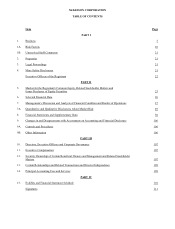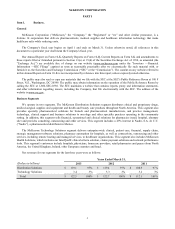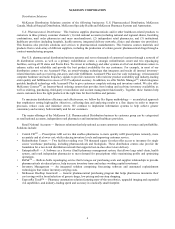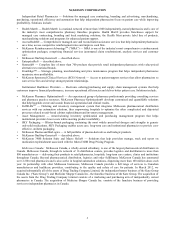McKesson 2013 Annual Report Download - page 18
Download and view the complete annual report
Please find page 18 of the 2013 McKesson annual report below. You can navigate through the pages in the report by either clicking on the pages listed below, or by using the keyword search tool below to find specific information within the annual report.12
McKESSON CORPORATION
Generic drug manufacturers are increasingly challenging the validity or enforceability of patents on branded
pharmaceutical products. During the pendency of these legal challenges, a generics manufacturer may begin manufacturing
and selling a generic version of the branded product prior to the final resolution to its legal challenge over the branded
product's patent. To the extent we source, contract manufacture, and distribute such generic products, the brand-name
company could assert infringement claims against us. While we generally obtain indemnification against such claims from
generic manufacturers as a condition of distributing their products, there can be no assurances that these rights will be
adequate or sufficient to protect us.
In recent years, pharmaceutical suppliers have been subject to increasing consolidation. As a result, a small number of
very large companies control a significant share of the market. Accordingly, we depend on fewer suppliers for our products
and therefore we may be less able to negotiate price terms with suppliers.
Many healthcare organizations have also consolidated to create larger healthcare enterprises with greater market power.
If this consolidation trend continues, it could reduce the size of our target market and give the resulting enterprises greater
bargaining power, which may lead to erosion of the prices for our products and services. In addition, when healthcare
organizations combine they often consolidate infrastructure including IT systems, which in turn may erode the diversity of
our customer and revenue base.
The healthcare industry is highly regulated, and further regulation of our distribution businesses and computer-related
products and services could impose increased costs, negatively impact our profit margins, and the profit margins of our
customers, delay the introduction or implementation of our new products, or otherwise negatively impact our business and
expose the Company to litigation and regulatory investigations.
Healthcare Fraud: We are subject to extensive and frequently changing local, state and federal laws and regulations
relating to healthcare fraud, waste and abuse, and the government, both state and federal, continues to strengthen its position
and scrutiny over practices involving fraud, waste and abuse affecting Medicare, Medicaid and other government healthcare
programs. Our relationships with pharmaceutical and medical-surgical product manufacturers and healthcare providers, as
well as our provision of products and services to government entities, subject our business to laws and regulations on fraud
and abuse, which among other things: (1) prohibit persons from soliciting, offering, receiving or paying any remuneration in
order to induce the referral of a patient for treatment or for inducing the ordering or purchasing of items or services that are in
any way paid for by Medicare, Medicaid or other government-sponsored healthcare programs; (2) impose a number of
restrictions upon referring physicians and providers of designated health services under Medicare and Medicaid programs;
and (3) prohibit the knowing submission of a false or fraudulent claim for payment to, and knowing retention of an
overpayment by, a federal health care program such as Medicare and Medicaid. Many of the regulations applicable to us,
including those relating to marketing incentives, are vague or indefinite and have not been interpreted by the courts. They
may be interpreted or applied by a prosecutorial, regulatory, or judicial authority in a manner that could require us to make
changes in our operations. If we fail to comply with applicable laws and regulations, we could become liable for damages,
suffer civil and criminal penalties, including the loss of licenses or our ability to participate in Medicare, Medicaid and other
federal and state healthcare programs.
Reimbursements: Both our profit margins and the profit margins of our customers may be adversely affected by laws
and regulations reducing reimbursement rates for pharmaceuticals, medical treatments and related services, or changing the
methodology by which reimbursement levels are determined. For example, the Patient Protection and Affordable Care Act
and the Health Care and Education Reconciliation Act (collectively the “Affordable Care Act”), signed into law in 2010,
revised the federal upper limits for Medicaid reimbursement for multiple source generic drugs available for purchase by retail
community pharmacies on a nationwide basis to a limit of not less than 175% of the weighted average (determined on the
basis of utilization) of the most recently reported monthly average manufacturer price (“AMP”) using a smoothing process. In
addition, Medicare, Medicaid and the State Children's Health Insurance Program (“SCHIP”) Extension Act of 2007 requires
the Centers for Medicare and Medicaid Services (“CMS”) to adjust the calculation of the Medicare Part B drug average sales
price to an actual sales volume basis. CMS has proposed new rules for calculating AMP (“Revised AMP”) and is also
offering states the option to replace traditional reimbursement metrics for certain drugs with alternatives such as the average
acquisition cost (“AAC”) method. Under AAC, reimbursement is based on the actual acquisition costs from invoiced amounts
and from a statistically validated cost of dispensing survey.
In addition, CMS has begun conducting a national survey of pharmacies to create a national average drug acquisition
cost benchmark (“NADAC”). States may use the results of this survey to set pharmacy payment rates. CMS released the first
draft of the pricing data determined through the NADAC survey as well as an alternate reimbursement methodology called
National Average Retail Price (“NARP”). NARP represents the average consumer purchase price of the most commonly
dispensed brand and generic drugs. States will have the option of using any of these metrics to determine appropriate
Medicaid reimbursement to pharmacies for generic or brand drugs.
























